In the world of electronics, switches are fundamental components used to control the flow of current. Two popular types of switches are relays and Metal-Oxide-Semiconductor Field-Effect Transistors (MOSFETs). Both devices have their unique advantages and limitations. This article will provide a comparative analysis between relays and MOSFETs, helping you determine which is more suitable for your application.
----------------------------
Operational Principles:
MOSFET:
A MOSFET is a type of Field Effect TransistorFET, which uses voltage to regulate the flow of current. There's a gate, a drain, and a source at the core of the MOSFET. An electric field is created by applying voltage to the gate, which will influence the flow of electrical current between the drain and the source.
Relay:
A relay is an electromagnetical switch based on the principle of electromagnetic induction, where a coil generates an electric magnetic field as it is powered. This magnetic field causes the switch contacts to be closed or opened, attracting a movable armature.
----------------------------
Switching speed:
MOSFET:
MOSFETs, like solid-state devices, exhibit a much more rapid change frequency ranging from nanoseconds up to microseconds. As a result, they are ideal for high-frequency applications. MOSFETs can thus be used in PWM applications as well.
Relay:
Relays generally have a slower transition time between on and off states than MOSFETs. The main reson for this delay is because relays have mechanical parts that need to move when the relay switches. Relays can thus not be used in PWM applications.
----------------------------
Longevity and Durability:
MOSFET:
MOSFETs can last a considerable time more than the relay since there are no movement parts in them, and they can be exposed to high voltage and temperature disturbances that may cause early failure if not taken care of.
Relay:
The relay has a limited life expectancy because of its mechanical nature. It may result in wear and tear or failure if the contacts are constantly opened and closed. Their life span can also be reduced by outside factors such as arcing.
----------------------------
Isolation:
MOSFET:
MOSFETs do not inherently provide isolation between the gate and source-drain circuitry. The use of optocouplers or other methods may be used for the isolation, but it is necessary to include complementary components.
Relay:
The ability of Relays to offer electrical isolation from the control input and load output circuits is one of its most important advantages. In the case of applications with safety or noise immunity issues, this may be particularly helpful.
----------------------------
Power Consumption:
MOSFET:
A MOSFET has less voltage drop in the 'on' state and therefore, a lower power dissipation. Nevertheless, transient loss of power may occur as a result of switching.
Relay:
Due to the need for constant power stimulation of the coil in order to maintain its switchable state, relays are thus generally consuming more energy.
----------------------------
Application with Microcontrollers
MOSFET:
Making use of logic level MOSFETs can simply your circuit a bit when you want to use a microcontroller to trigger the gate. Because logic level MOSFETs can be switched on completely with 3.3V, you can easily switch the MOSFET with almost any microcontroller without having to add external circuitry. Power MOSFETs on the other hand need to be switched with higher voltages and will require external circuitry.
Relay:
If you are using a microcontroller that can only outout 3.3V on the I/O pins, it can complicate your circuit if you are not using a module built to be used with a microcontroller. Even though a 5V relay can switch on using an Arduino, microcontrollers can generally only provide around 500mA, which means that the relay can require more current than the Arduino can offer and cause the Arduino to shut down.
----------------------------
Wave Form:
MOSFET:
Single-channel MOSFETs only work with direct current and can not operate with an alternating current. If you want to work with alternating current, you can use a combination of MOSFETS and some external circuitry.
Relay:
Because a relay is a mechanical switch that uses an armature, you can switch alternating current with high voltages such as 110V up to 220V.
----------------------------
Current and Voltage Rating:
MOSFET:
MOSFETs can generally work with very low or very high current that goes up to hundreds of Amps, and it does not create an arc when it switches on with high current and voltage. MOSFETs can work with high and low voltages, but because they operate with direct current, they generally are used in applications lower than 100V.
Relay:
Relays can operate with low current aswell, but the maximum current that can be used on a relay is generally under 100A, and the relay will create an arc when it switches on when using it under high voltage and high current conditions.
----------------------------
Conclusion
In the end, it is ultimately up to the specific needs of the application that will determine which, a relay or a MOSFET, should be used. A MOSFET would be an appropriate choice if you need fast switching speed, a compact form factor, and a lifespan that is not of concern to wear and tear. A relay may be more suitable if you require electric isolation for a bigger dimension or any application that does not require rapid switching.
It is important to consider the merits and disadvantages of each option, as in any engineering decision. In some cases, in order to achieve optimum performance and reliability, a combination of both relay and MOSFETs may be the best solution.

